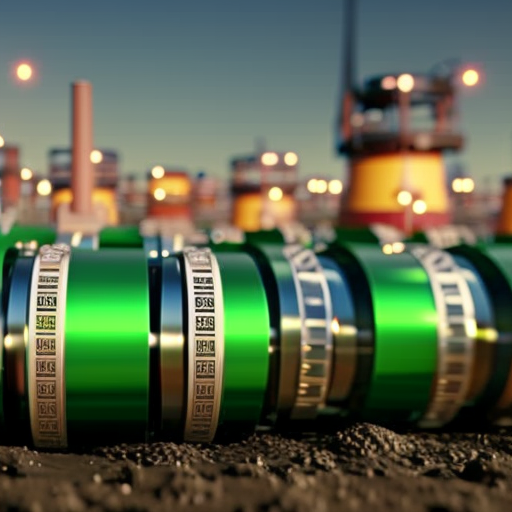
The Biden Administration’s Efforts to Reduce Emissions from Heavy Industries

Industries produce 25 percent of America’s planet-warming emissions but so far have proved very hard to clean up. The Biden administration is trying.
The Biden administration plans to spend up to $6 billion on new technologies to cut carbon dioxide emissions from heavy industries like steel, cement, chemicals, and aluminum, which are all enormous contributors to global warming but which have so far been incredibly difficult to clean up.
Energy Secretary Jennifer Granholm said Monday that her agency would partially fund 33 different projects in 20 states to test methods for curbing emissions from a wide variety of factories and industrial plants, calling it “the single largest industrial decarbonization investment in American history.”
Constellium, an aluminum producer, would receive up to $75 million to build a first-of-a-kind aluminum casting plant in Ravenswood, W.Va., that can run on cleaner burning hydrogen fuels rather than natural gas.
Kraft Heinz, a food manufacturer, would get up to $170.9 million to install electric boilers and heat pumps at 10 facilities across the country, where they would be used to generate the large amounts of heat needed for things like drying macaroni without directly burning fossil fuels.
Cleveland-Cliffs, a steel manufacturer, would get up to $500 million to help retire a large coal-consuming blast furnace in Middletown, Ohio, and replace it with two furnaces that use electricity to turn scrap into steel. The company would also test ways to produce steel using hydrogen.
While the projects themselves would put a relatively small dent in U.S. emissions, Ms. Granholm said the goal was to demonstrate novel technologies that can scale up rapidly and “set a new gold standard for clean manufacturing in the United States and around the world.”
SDGs, Targets, and Indicators Analysis
1. Which SDGs are addressed or connected to the issues highlighted in the article?
- SDG 7: Affordable and Clean Energy
- SDG 9: Industry, Innovation, and Infrastructure
- SDG 13: Climate Action
The article discusses the Biden administration’s plan to cut carbon dioxide emissions from heavy industries, such as steel, cement, chemicals, and aluminum. These industries are major contributors to global warming, and addressing their emissions aligns with SDG 7 (Affordable and Clean Energy), SDG 9 (Industry, Innovation, and Infrastructure), and SDG 13 (Climate Action).
2. What specific targets under those SDGs can be identified based on the article’s content?
- SDG 7.2: Increase substantially the share of renewable energy in the global energy mix.
- SDG 9.4: Upgrade infrastructure and retrofit industries to make them sustainable, with increased resource-use efficiency and greater adoption of clean and environmentally sound technologies and industrial processes.
- SDG 13.2: Integrate climate change measures into national policies, strategies, and planning.
The article highlights the Biden administration’s plan to invest in new technologies that can help reduce carbon dioxide emissions from heavy industries. This investment aims to increase the share of renewable energy in the energy mix of these industries (target 7.2), upgrade infrastructure and retrofit industries to make them sustainable (target 9.4), and integrate climate change measures into national policies and planning (target 13.2).
3. Are there any indicators mentioned or implied in the article that can be used to measure progress towards the identified targets?
- Investment amount in new technologies for emissions reduction
- Number of projects funded
- Amount of funding allocated to each project
- Reduction in carbon dioxide emissions from heavy industries
- Increased share of renewable energy in the energy mix of heavy industries
The article mentions the Biden administration’s plan to spend up to $6 billion on new technologies to cut carbon dioxide emissions from heavy industries. The investment amount and the number of projects funded can be used as indicators to measure progress towards the identified targets. Additionally, the reduction in carbon dioxide emissions and the increased share of renewable energy in the energy mix of heavy industries can also serve as indicators of progress.
SDGs, Targets, and Indicators Table
| SDGs | Targets | Indicators |
|---|---|---|
| SDG 7: Affordable and Clean Energy | 7.2 Increase substantially the share of renewable energy in the global energy mix. | – Investment amount in new technologies for emissions reduction – Increased share of renewable energy in the energy mix of heavy industries |
| SDG 9: Industry, Innovation, and Infrastructure | 9.4 Upgrade infrastructure and retrofit industries to make them sustainable, with increased resource-use efficiency and greater adoption of clean and environmentally sound technologies and industrial processes. | – Investment amount in new technologies for emissions reduction – Number of projects funded – Amount of funding allocated to each project |
| SDG 13: Climate Action | 13.2 Integrate climate change measures into national policies, strategies, and planning. | – Investment amount in new technologies for emissions reduction – Reduction in carbon dioxide emissions from heavy industries |
Behold! This splendid article springs forth from the wellspring of knowledge, shaped by a wondrous proprietary AI technology that delved into a vast ocean of data, illuminating the path towards the Sustainable Development Goals. Remember that all rights are reserved by SDG Investors LLC, empowering us to champion progress together.
Source: nytimes.com

Join us, as fellow seekers of change, on a transformative journey at https://sdgtalks.ai/welcome, where you can become a member and actively contribute to shaping a brighter future.




